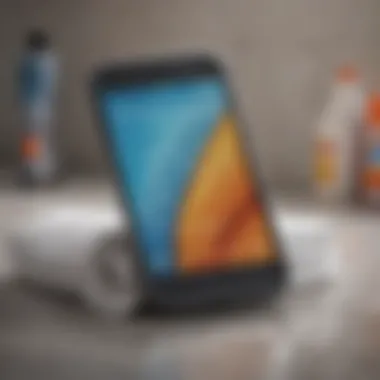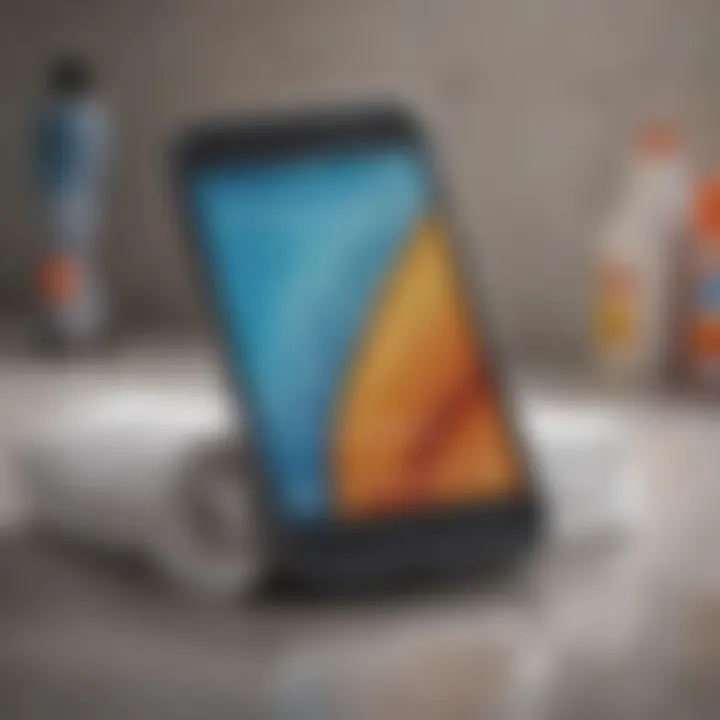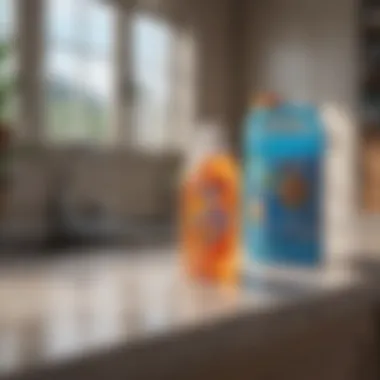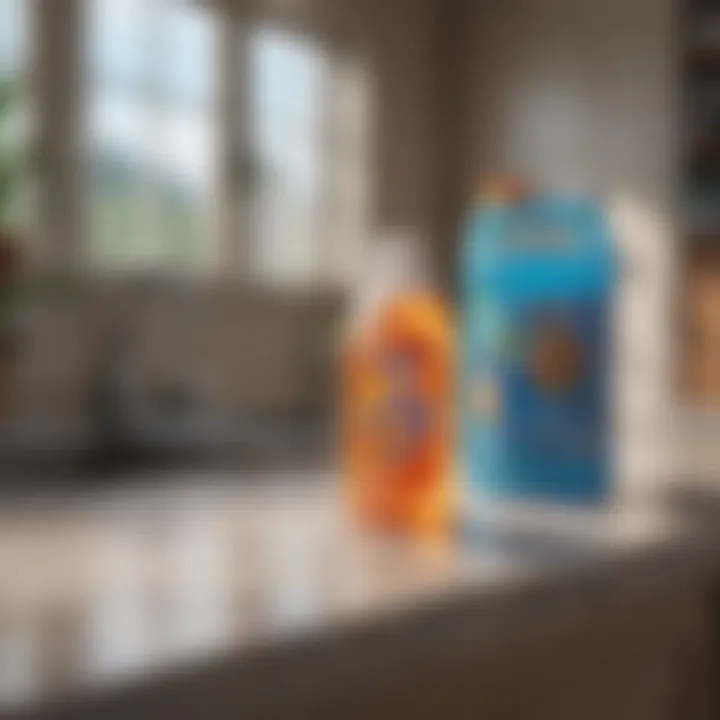Using Clorox Wipes on Your Phone: Risks and Benefits


Intro
In today’s world, mobile phones serve not only as communication tools but also as essential devices handling many daily tasks. With this extensive usage comes an equally significant concern regarding cleanliness. Clorox wipes have gained popularity for their sanitation capabilities, but their application on electronic devices, particularly mobile phones, raises questions about safety and effectiveness.
This article unpacks the various facets of using Clorox wipes on your phone. It delves into safety aspects, the effectiveness of these wipes, alternative methods for cleaning, and potential long-term impacts on electronic devices. As people become increasingly health-conscious, understanding the implications of phone sanitation becomes crucial. Hence, we aim to furnish readers with clear insights that align with maintaining their phones' functionality and hygiene. Let's begin by examining the primary areas of concern surrounding this topic.
Intro to Phone Sanitation
In recent years, the topic of phone sanitation has gained significant attention. Mobile devices, such as smartphones, have become essential tools in our daily lives. However, they are also hotspots for germs and bacteria. It is vital to understand the implications of not cleaning mobile devices regularly. This article intends to highlight the importance of proper sanitation, particularly when using products like Clorox wipes.
Importance of Cleaning Mobile Devices
Cleaning mobile devices is imperative for several reasons. First, our phones come into contact with our hands, faces, and various surfaces throughout the day. This constant interaction leads to the accumulation of dirt, dust, and microbes. In fact, studies show that the average smartphone harbors more bacteria than a toilet seat. Regular cleaning can reduce the risk of transmitting harmful pathogens, making it a straightforward yet effective health measure.
Second, a sanitized phone contributes to a better overall experience. A clean screen is not only more pleasant to use but also improves visibility. Unclean devices may hinder functionality, especially if grime builds up in physical openings like charging ports or speakers. This aspect alone warrants regular attention.
Health Risks of Dirty Phones
Dirty phones pose genuine health risks. Apart from the visible grime, unseen bacteria can lead to infections and illnesses. Germs from surfaces may find their way to our hands, and subsequently to our faces or mouths. This process considerably increases the chances of illness, especially in communal settings where individuals frequently share devices.
Moreover, certain viruses can survive on phone surfaces for extended periods. For instance, the coronavirus has been shown to remain viable on plastic and stainless steel surfaces for several days. This statistic emphasizes the urgent need for frequent cleaning routines to mitigate risks associated with viral transmission.
Understanding Clorox Wipes
Understanding Clorox wipes is essential for anyone considering their use on mobile devices. These wipes are widely popular due to their convenience and effectiveness in killing germs on various surfaces. However, when it comes to cleaning electronics, several aspects must be considered. Knowing what goes into these wipes and how they work can help users make informed decisions. Additionally, comprehending their intended applications can clarify their suitability for use on sensitive devices like smartphones.
Composition of Clorox Wipes
Clorox wipes are primarily made of a non-woven fabric that is saturated with a cleaning solution. The active ingredient is usually sodium hypochlorite, which is a bleach compound known for its disinfecting properties. This agent is effective against a variety of pathogens, including bacteria and viruses.
Other components may include water, detergents, and various fragrances. These ingredients work together to provide both cleanliness and a pleasant smell. Importantly, the presence of sodium hypochlorite emphasizes the need for caution. While it disinfects well, it may also pose risks to certain surfaces, especially those on delicate devices.
Intended Uses and Efficacy
Clorox wipes are designed for disinfecting hard, non-porous surfaces. They are effective in killing 99.9% of germs and suitable for areas like kitchen counters, bathroom fixtures, and doorknobs. Their efficacy has been supported by various studies, demonstrating that they can reduce microbial counts effectively on surfaces typically encountered in households and public settings. However, when considering their use on phones, one must weigh the potential benefits against risks.
Using Clorox wipes on a smartphone can remove visible dirt and some germs; nevertheless, their harsh ingredients can lead to unintended damage. For instance, prolonged exposure may degrade screen coatings, affect tactile responsiveness, or interfere with other components. Therefore, understanding the formulated purpose of these wipes, alongside their disinfecting power, plays a crucial role in their application on phones.
"While Clorox wipes are effective for killing germs, they may not be suitable for electronic devices due to potential damage to screens and components."


Can You Use Clorox Wipes on Your Phone?
This section addresses a crucial inquiry regarding the cleaning of mobile devices. The surface of smartphones acts as a reservoir for bacteria and germs. With the increasing awareness of health and hygiene, many individuals look for effective methods to sanitize their devices. Clorox Wipes are commonly suggested due to their antibacterial properties. However, this recommendation is not without caveats. The benefits of cleanliness must be weighed against the potential risks that certain cleaning agents may pose to sensitive electronic components.
Manufacturer Recommendations
Most smartphone manufacturers provide guidelines for cleaning their devices. These recommendations are essential for maintaining device longevity and ensuring optimum performance.
- Apple typically advises against using any cleaning wipes containing bleach or abrasives. Instead, they suggest a gentle cleaning with a soft, lint-free cloth.
- Samsung also cautions against using any products containing alcohol or ammonia on their devices. They recommend using a damp microfiber cloth.
The key takeaway from these recommendations stresses the importance of following manufacturer guidelines. Clorox Wipes contain strong chemicals that may not align with these recommendations, raising concerns about potential damage.
Testing and Safety Considerations
As we evaluate the safety of using Clorox Wipes on your phone, proper testing and assessments are pertinent. Several safety considerations arise, primarily linked to the composition of Clorox Wipes. These wipes typically contain quaternary ammonium compounds, which are effective in sanitizing but may harm the device’s screen coatings. Common outcomes from using incompatible cleaning solutions include:
- Discoloration or clouding of the screen surface.
- Deterioration of protective coatings, especially oleophobic coatings that resist fingerprints.
- Corrosion of internal components if moisture seeps into openings or buttons.
It is wise to conduct a patch test on less visible areas of the device to gauge any initial reaction before proceeding with a comprehensive clean. If damage occurs, subsequent repairs can be costly and may lead to a compromised user experience.
The consensus among experts is that while sanitation is critical, the method of cleaning must be safe for the device's technology.
Ultimately, while Clorox Wipes present a tempting solution for phone sanitation, it is prudent to explore all aspects before employing them for this purpose.
Potential Risks of Using Clorox Wipes on Phones
The usage of Clorox wipes on mobile devices presents several risks that should not be overlooked. While sanitizing phones has become a necessary practice, understanding the implications of using a strong cleaning agent is crucial. Clorox wipes contain chemicals that can potentially harm various components of mobile devices. This section evaluates two primary concerns: the impact on screen coatings and damage to device components.
Impact on Screen Coatings
Mobile device screens often have protective coatings designed to enhance touch sensitivity and reduce glare. Clorox wipes might disrupt this balance. Continuous use can lead to degradation of these coatings, resulting in diminished screen clarity and responsiveness. Some users report a hazy appearance or even scratching due to the abrasive nature of certain cleaning agents. Moreover, many manufacturers warn against the use of these wipes, emphasizing that damage to screen coatings is not covered under warranty.
Key Points Regarding Screen Coating Damage:
- Chemical Reactions: The ingredients in Clorox wipes can react negatively with the coatings, breaking down their protective properties.
- Abrasiveness: Even if the wipes appear soft, repeated usage can scratch screens, affecting usability and aesthetics.
- Warranty Concerns: Damage resulting from improper cleaning methods can void warranties, leaving users liable for repairs.
Damage to Device Components
In addition to the screen, other components may also face risks when using Clorox wipes. Electronics are sensitive to moisture and strong chemicals. Clorox wipes contain moisture, which can seep into device openings and connectors, potentially causing short circuits or corrosion. This risk is particularly high for devices with ports that are not fully sealed.
Considerations for Damage to Components:


- Corrosion Risks: Chemical exposure may corrode internal circuit boards or contacts over time.
- Moisture Damage: Excessive moisture can lead to functional failures, such as malfunctioning buttons or connectivity issues.
- Repair Costs: Damage to internal components often necessitates expensive repairs or complete replacements.
"While it may seem appealing to sanitize your phone with Clorox wipes, the long-term consequences could outweigh the immediate benefits."
In summary, it is essential to weigh the risks of using Clorox wipes on mobile devices against their cleaning efficacy. Understanding these potential problems allows users to make informed decisions about device sanitation.
Alternatives to Clorox Wipes
The discussion around cleaning mobile devices often leads to Clorox wipes. However, it's essential to recognize that there are effective alternatives to these antimicrobial wipes. Exploring different cleaning methods not only expands your options but also allows you to choose a solution that aligns better with your device's needs and your cleaning preferences. This exploration focuses on the practicalities, benefits, and considerations associated with alternatives.
Microfiber Cloths
Microfiber cloths have gained recognition in the cleaning industry for their effectiveness in lifting dirt and oils without the use of chemicals. Their ultra-fine fibers can penetrate small spaces, making them well-suited for wiping screens and surfaces.
Here are some key advantages of using microfiber cloths:
- Gentle on Surfaces: They do not scratch screens, ensuring that your device remains in good condition.
- Reusable and Washable: Unlike Clorox wipes, microfiber cloths can be easily cleaned and reused, reducing waste.
- No Chemicals Needed: With just water, these cloths can effectively clean fingerprints and smudges.
To use a microfiber cloth, simply dampen it slightly with water and wipe the screen or device surface gently. It is important to avoid excessive moisture that could seep into device components.
Alcohol-based Solutions
Alcohol-based cleaning solutions offer another viable alternative for phone sanitation. These solutions typically contain isopropyl alcohol and can be effective in killing germs and bacteria.
When opting for alcohol solutions, consider the following:
- Dilution Matters: It is advisable to use solutions with at least 70% isopropyl alcohol for effective disinfection.
- Avoid Excessive Saturation: Apply the solution to a cloth instead of directly on the phone to minimize damage risk.
- Quick Drying: Alcohol evaporates quickly, making it less likely to damage electronic components when used properly.
For an effective clean, spray the solution onto a clean cloth and gently wipe the surfaces of your phone. The alcohol will help sanitize without leaving a residue.
UV Sanitizers
Another innovative cleaning alternative is the use of UV sanitizers. These devices utilize ultraviolet light to kill bacteria and viruses present on surfaces.
- Chemical-Free Cleaning: They sanitize devices without needing any fluids or chemicals, making them a safe option for electronics.
- Fast and Effective: Many UV sanitizers only require a few minutes to effectively sanitize your phone.
- Multi-Use Functionality: Some models can sanitize various items, including keys and credit cards, offering broader utility.
To use a UV sanitizer, place your phone inside the device following the manufacturer's instructions and activate the cleaning cycle. It’s a simple and efficient way to maintain hygiene while safeguarding your phone against potential damage from liquid cleaners.
Best Practices for Cleaning Mobile Devices


Maintaining cleanliness of mobile devices is crucial for various reasons. It not only reduces the build-up of germs but also prolongs the lifespan of your device. Having a regular cleaning routine can significantly impact your health and device performance. This section discusses key aspects of best practices for cleaning your mobile devices, emphasizing frequency and effective techniques.
Frequency of Cleaning
The frequency of cleaning your phone directly affects its hygiene and sustainability. In general, it is advisable to clean your device at least once a week. This helps to remove any accumulated bacteria, oils, or dust. However, certain circumstances may require more frequent cleaning. For example, if you often take your phone to public places or share it with others, daily cleaning is recommended.
- Daily cleanings may be necessary if:
- You work in crowded environments.
- You handle your phone while eating or drinking.
- You use your phone in public transport.
In contrast, individuals who predominantly use their phones at home might only need to clean once a week. It's important to assess your own habits and environments to determine the best frequency for your cleaning routine.
Effective Techniques
Cleaning your mobile device effectively not only ensures hygiene but also protects the physical integrity of the device. Here are some recommended techniques:
- Use Appropriate Cleaning Materials:
- Dampen the Cloth:
- Wipe Gently:
- Disinfecting Ports and Speakers:
- Handle with Clean Hands:
- Microfiber cloths are ideal as they are soft and non-abrasive.
- Avoid paper towels or rough cloths, as they can scratch screens.
- Lightly dampen the microfiber cloth with water or a suitable cleaning solution. Ensure it is not dripping wet.
- Products containing alcohol and disinfectants can be used but check compatibility with your device materials first.
- Use a gentle circular motion while wiping the screen and exterior surfaces.
- Avoid excessive pressure, especially on sensitive areas like cameras or buttons.
- For crevices, use a soft brush or a dry cloth to prevent accumulation of dirt without damaging ports.
- Never put liquid directly into ports or speakers.
- Make it a habit to wash your hands before using your phone. This reduces the transfer of germs right from the start.
"Regular cleaning not only promotes health, it also preserves the aesthetic and functional quality of your device."
Adhering to these best practices will not only keep your device clean but also enhance your overall experience as a mobile device user.
Culmination
The conclusion serves as a vital component in the discussion of using Clorox wipes on mobile devices. It distills the key insights gathered throughout the article, ensuring that the reader leaves with a clear understanding of the topic. In a world where health and hygiene are increasingly prioritized, the cleanliness of our mobile devices has become a pressing concern. This article emphasizes the importance of finding effective and safe methods for sanitation without compromising the functionality of the devices we depend on.
Summarizing Key Points
Throughout the article, several critical observations were made regarding the use of Clorox wipes on phones. First, it was established that while these wipes are effective at killing germs, they can potentially damage phone screens and coatings. Key points include:
- Health Risks: Dirty phones pose identifiable health risks, and proper cleaning methods can mitigate these dangers.
- Composition and Efficacy: Clorox wipes contain chemicals designed for cleaning hard surfaces, which can lead to unintended effects on electronic devices.
- Safe Alternatives: There are several viable alternatives, such as microfiber cloths or UV sanitizers that offer effective cleaning without the risks associated with chemicals in disinfectant wipes.
- Best Practices: You should establish clear cleaning routines and techniques to maintain device cleanliness efficiently.
Final Recommendations
Based on the analysis presented, several recommendations emerge:
- Use Caution: Avoid using Clorox wipes directly on phones to prevent damage to delicate components.
- Explore Alternatives: Consider using microfiber cloths or alcohol-based solutions that are safe for electronics.
- Regular Maintenance: Establish a regular cleaning schedule to minimize the accumulation of germs on devices.
- Manufacturer Guidance: Always consult the manufacturer’s cleaning guidelines specific to your device model to ensure safety and compliance with warranty terms.







